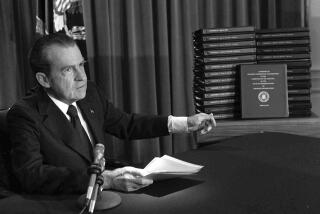Behind the Tower Debacle Is a Growing Power Struggle Between Congress, Presidents
- Share via
John Tower’s failed nomination to be secretary of defense has been viewed by many people as a test of George Bush’s presidential power. They are right, of course, but most fail to recognize the deeper struggle (30 years in the making) taking place over the balance of power between Congress and the President.
Tower’s nomination was clearly a close call, with respected members of both parties undecided until the last moment. The Senate Democrats could easily have accepted the President’s choice, deferring to his judgment about who should serve in his Cabinet. They chose not to.
The last time the Senate rejected a Cabinet nomination was in 1959. The greater willingness of Congress to second-guess a President has many roots, but one of the most important is a relatively new phenomenon: institutional partisanship between Congress and the Executive.
Bush’s election marked the fifth Republican victory in the last six presidential elections. Many pundits think that, in good times at least, Republicans have a near lock on the presidency--and not merely because of the vagaries of the Electoral College. Since 1952, Republican presidential candidates have outpolled their Democratic opponents by 49 million votes.
At the same time, Democrats have had a similar hold on Congress. Not since 1952, when war-hero Dwight D. Eisenhower was elected, have the Republicans controlled both the House and the Senate. Although the Democrats lost the Senate in 1980, they won it back in 1986 and seem confident of keeping control.
This recent history of divided government is spurring a kind of institutional partisanship, with each party claiming not just a mandate for its policies but also the primacy of its branch of government in policy-making.
Contrary to popular impression, the Constitution does not establish absolute boundaries between the two branches. The actual line of demarcation shifts with changes in the balance of political power and personal leadership.
In any direct confrontation, however, a strong congressional majority is likely to prevail over a President. But with the notable exception of the era of the Radical Republicans during Reconstruction, Congress has rarely exercised the full extent of its powers to seek control over national policy. Instead, confrontations have been sporadic and usually over specific issues.
The major reason there have been so few confrontations is the early emergence of political parties. The President is usually the leader of his party. So almost from the beginning, party loyalty and discipline have safeguarded presidential powers and prerogatives. It was Republican control of the Senate and near-unanimous Republican support in the House (augmented by the Democratic boll weevils) that gave Ronald Reagan many of his early victories and, thus, his aura of political strength.
This very foundation of presidential power is now being sapped by the continuing partisan division between the legislative and executive branches. For most of our history, the same party has controlled both branches. Between 1789 and 1954, the party opposing the President controlled both houses of Congress for a mere 14 years--and never occurring more frequently than 16 years apart. After 1954, an opposition Congress became common. In half of the subsequent years, there has been a Democratic Congress and a Republican President.
Thus, recent Presidents have not been able to rely solely on party loyalty for political strength vis-a-vis Congress. It’s not really a matter of party ideology, for Republicans have been just as ready to assert congressional primacy when they controlled both houses. Between 1947 and 1949, the GOP Congress often rode roughshod over President Harry S. Truman. And it was the Republicans who undercut the modern presidency the most with the 22nd Amendment, which limits Presidents to two terms and turns every second-term President into an immediate lame duck.
So, add to George Bush’s other tasks the daunting one of protecting traditional executive powers from a resurgent congressional majority of Democrats. The cumulative results of numerous individual struggles between Bush and congressional Democrats may change the shape of our government for decades to come. Some will welcome this tension as a form of expanding democracy; others will fear that it threatens the established constitutional order that has served us well for 200 years.
But these are long-term concerns. In the short-term, Bush is suffering the effect of long years of divided government. On issue after issue, he will have to fight hard just to get to the position that all but his most recent predecessors could take for granted. He cannot assume that basic presidential prerogatives will be respected. That’s the real lesson of the Tower debacle.
More to Read
Get the L.A. Times Politics newsletter
Deeply reported insights into legislation, politics and policy from Sacramento, Washington and beyond. In your inbox twice per week.
You may occasionally receive promotional content from the Los Angeles Times.









